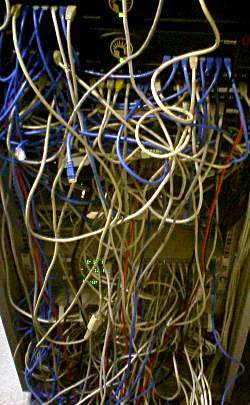Cable spaghetti
|
|
Cable spaghetti refers to the tangle of wires found behind and under most computers and audio/video equipment. It's the result of the increasing number of interconnected components used to create a home cinema or computer, without a standard cable management system. Typically, each signal is carried on a separate cable, using whatever connector has been customarily used for that type of signal in the past.
| Contents |
Proposed solutions
Cable spaghetti can be reduced by bus designs that permit "daisy chaining." For example, the Apple Desktop Bus on the Apple Macintosh uses a single cable chained from one device to another. This both reduces the length needed for cables and distributes the cables over a wider area, removing the potential for wires to catch, snag, or get tangled.
Computers
Modern computer systems use USB, a data connection standard which can be used as a data bus. The current design of most USB devices often requires the cables to be attached to a hub. In addition, it is unusual for a USB device to add a port to compensate for the space it uses. One device that does incorporate this feature is the keyboard for modern Macintoshes. An advantage of USB is that it allows less often used devices to be easily removed when not in use.
Wireless peripherals, specifically mice, keyboards and printers, have existed for some time. The number of wires required is reduced, but each device needs its own power source. Bluetooth is starting to replace IrDA and the proprietary RF used for computer peripherals.
Computer Networks
The move, in the early 1990s, from 10BASE2 using coax cable on a bus network to 10BASE-T and 100BASE-T using twisted pair on a star network has increased the number of cables needed. Wireless technologies like 802.11b are one possible solution, but they introduce other problems like security and interference.
Entertainment Systems
In the audio world there have been a tremendous number of attempts to provide a single cable containing left and right stereo in and out signals in a single cable. Older Pioneer Electronics systems often include a small round 4-pin DIN jack for this purpose, but so few devices supported it that they eventually gave up on it.
Today the problem is only made worse by the consolidation of Audio, Video, and Computer systems. Whereas a record player and cassette deck were likely the only two components found up to the 1980s, today's systems can have an amplifier, television, CD player, VCR, DVD player, personal video recorder, cable or satellite box, video game console, and computer all connected in the same room.
The 20-pin SCART system includes video and left-right audio output and input lines, along with numerous control lines integrated into one cable. More recently a digital optical fiber solution was proposed that would transmit video, audio, and control signals on a single universal connector.

